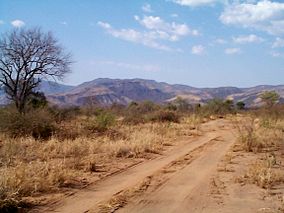Mago National Park
| Mago National Park | |
|---|---|
|
IUCN category II (national park)
|
|

Mago National Park, February 2006
|
|
|
Location in Ethiopia
|
|
| Location | Ethiopia |
| Coordinates | 5°40′N 36°10′E / 5.667°N 36.167°ECoordinates: 5°40′N 36°10′E / 5.667°N 36.167°E |
| Area | 2,220 km2 (860 sq mi) |
| Established | 1970 |
Mago National Park is one of the National Parks of Ethiopia. Located in the Southern Nations, Nationalities, and Peoples' Region about 782 kilometers south of Addis Ababa and north of a large 90° bend in the Omo River, the 2162 square kilometers of this park are divided by the Mago River, a tributary of the Omo, into two parts. To the west is the Tama Wildlife Reserve, with the Tama river defining the boundary between the two. To the south is the Murle Controlled Hunting Area, distinguished by Lake Dipa which stretches along the left side of the lower Omo. The park office is 115 kilometers north of Omorate and 26 kilometers southwest of Jinka. All roads to and from the park are unpaved.
The major environments in and around the Park are the rivers and riverine forest, the wetlands along the lower Mago and around Lake Dipa, the various grasslands on the more level areas, and scrub on the sides of the hills. Open grassland comprises about 9% of the park's area. The largest trees are found in the riverine forest beside the Omo, Mago and Neri. Areas along the lower Omo (within the park) are populated with a rich diversity of ethnic groups, including the Aari, Banna, Bongoso, Hamar, Karo, Kwegu, Male and Mursi peoples.
The Mago National Park was established in 1979, making it the newest of Ethiopia's several National Parks. Its highest point is Mount Mago (2528 meters). Indigenous bird life include the extremely uncommon Turdoides tenebrosus especially at Lake Dipa, Estrilda troglodytes in the rank grass along streams and swamp edges, Phoeniculus damarensis, Porphyrio alleni, Butorides striatus also at Lake Dipa, and in riverine contexts Pluvianus aegypticus, Scotopelia peli and Cossypha niveicapilla. The park's perhaps best known attraction are the Mursi, known for piercing their lips and inserting disks made of clay.
...
Wikipedia

